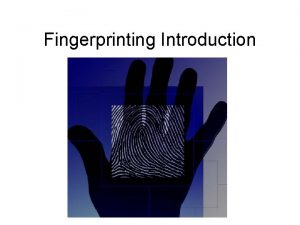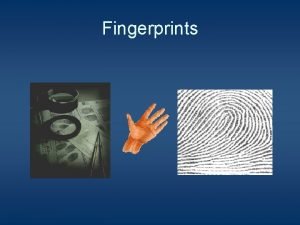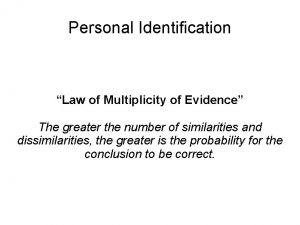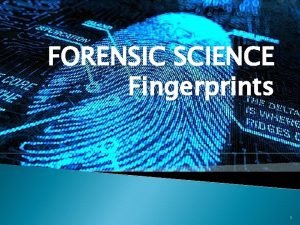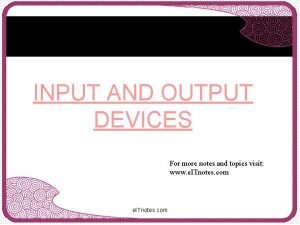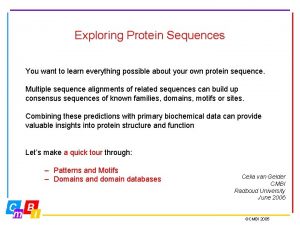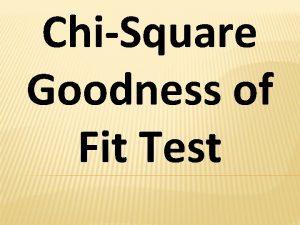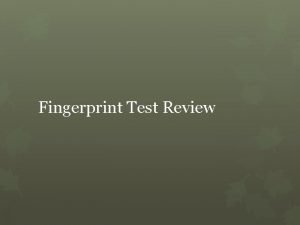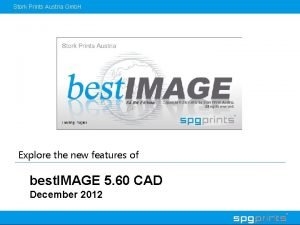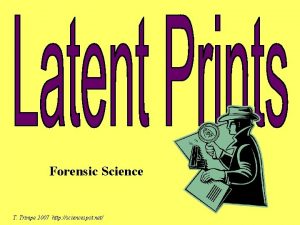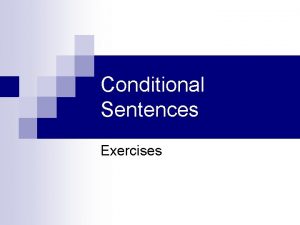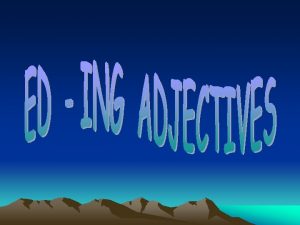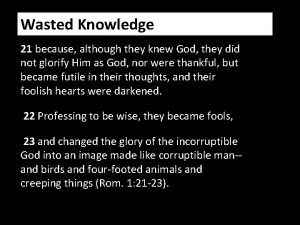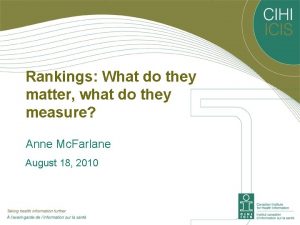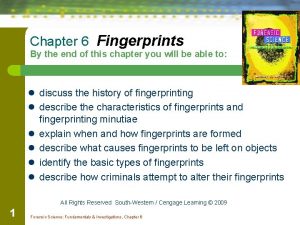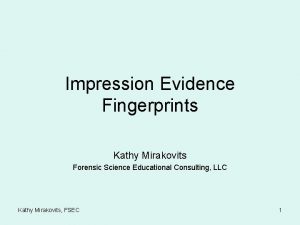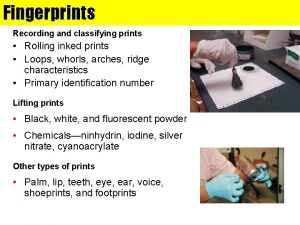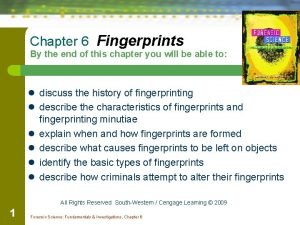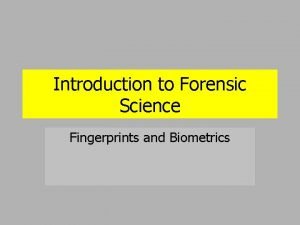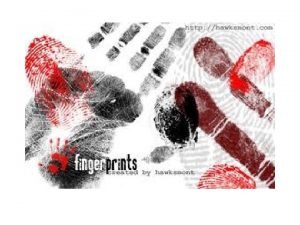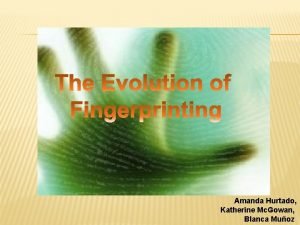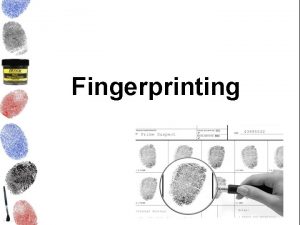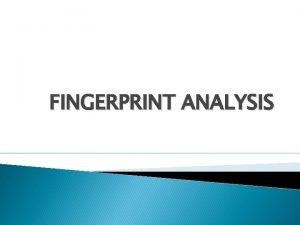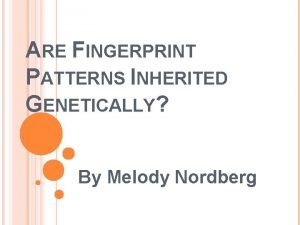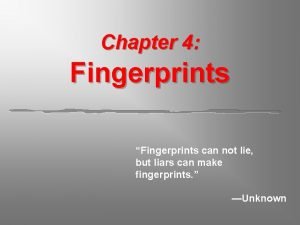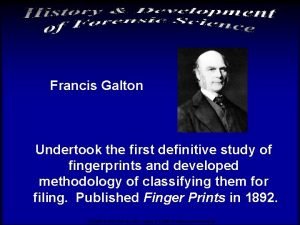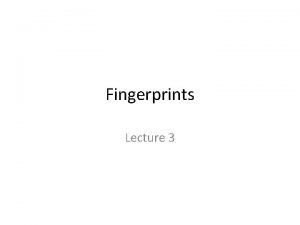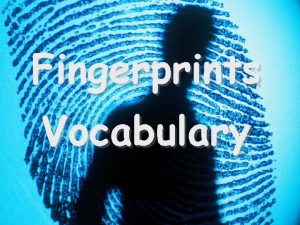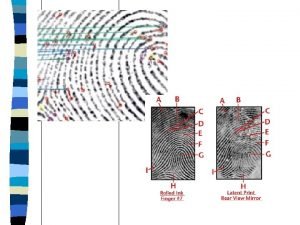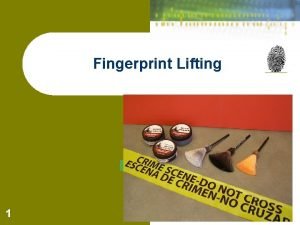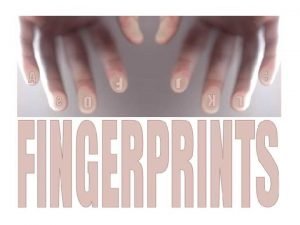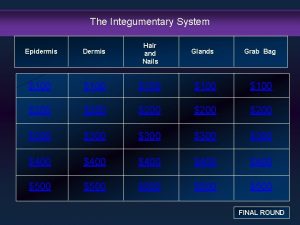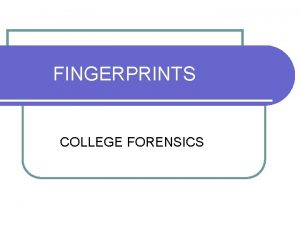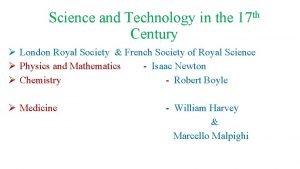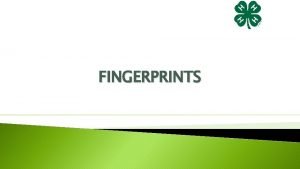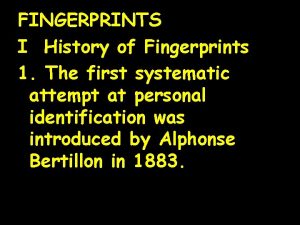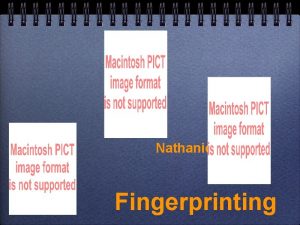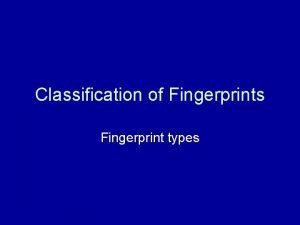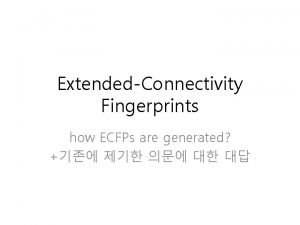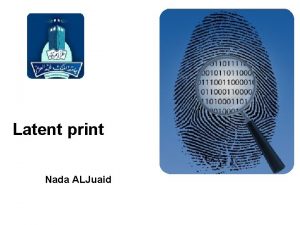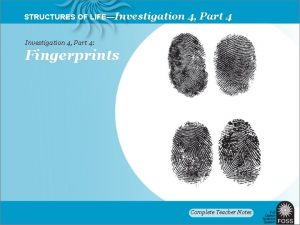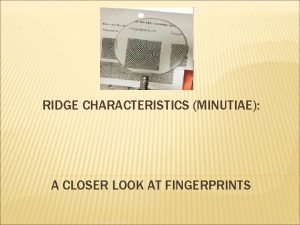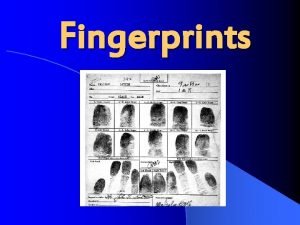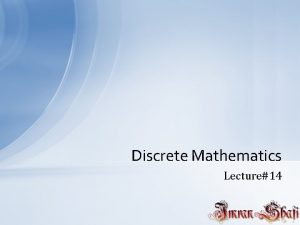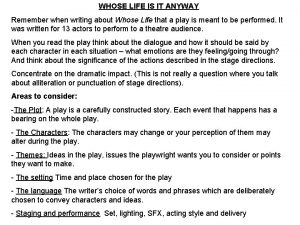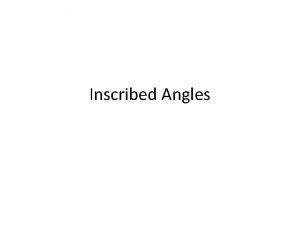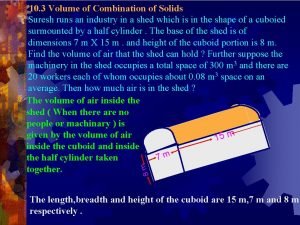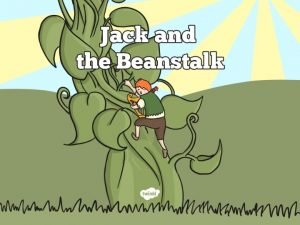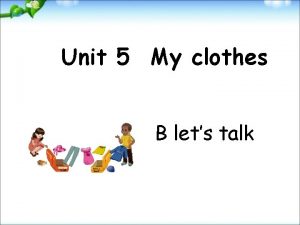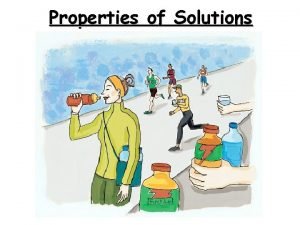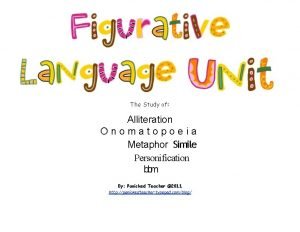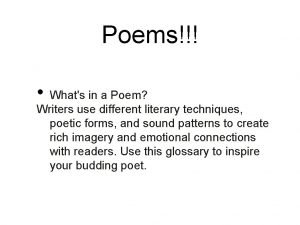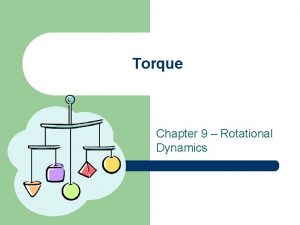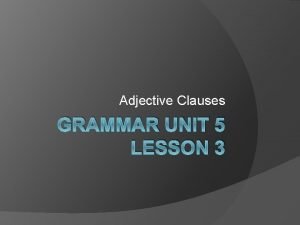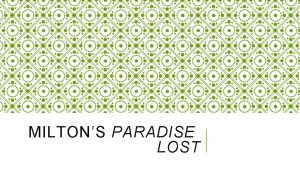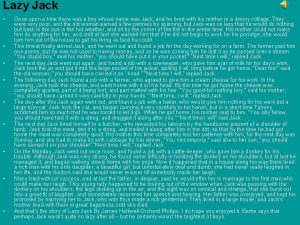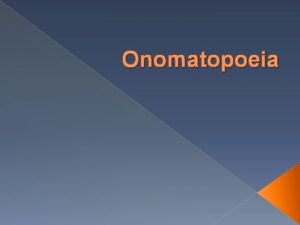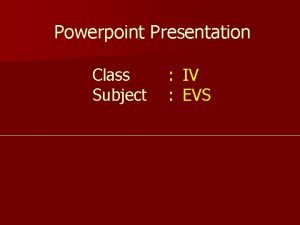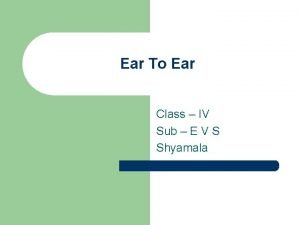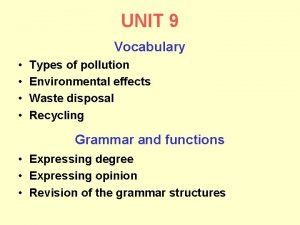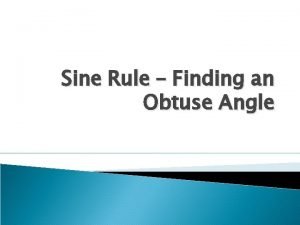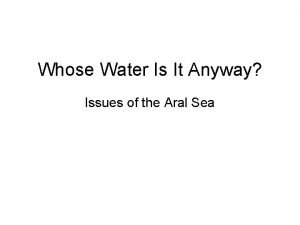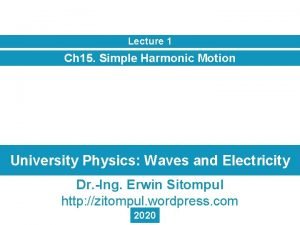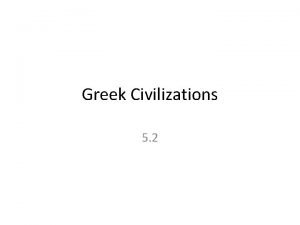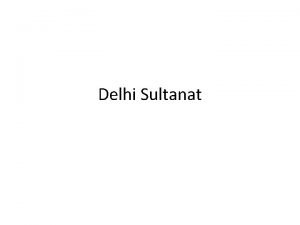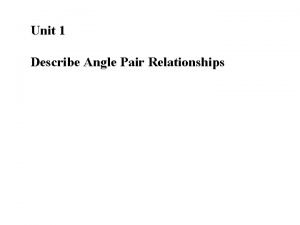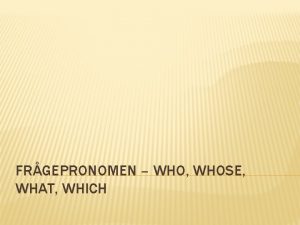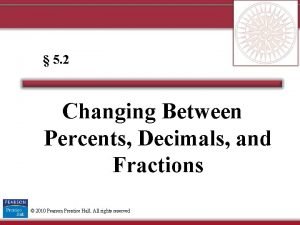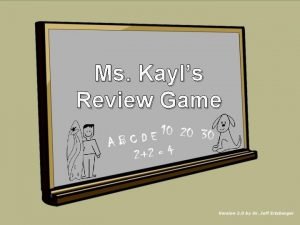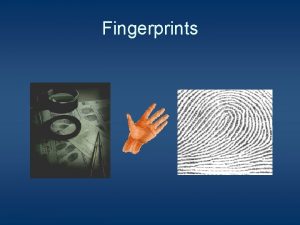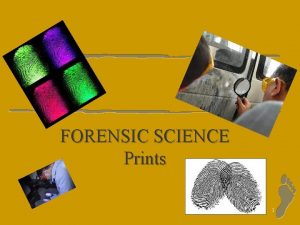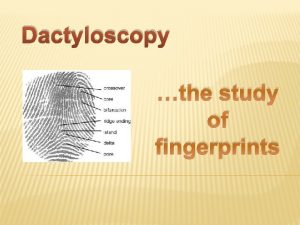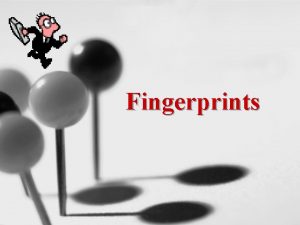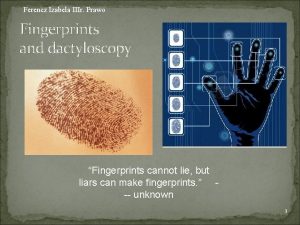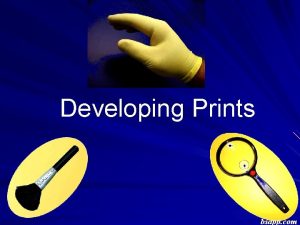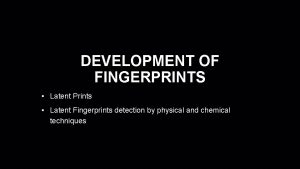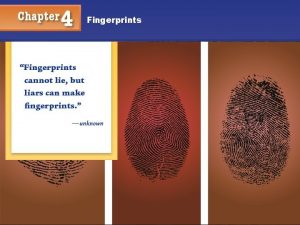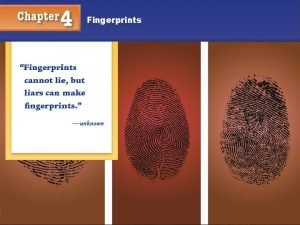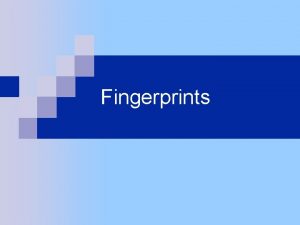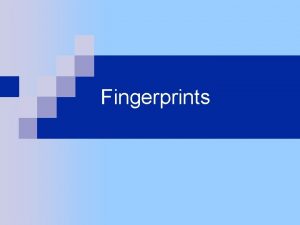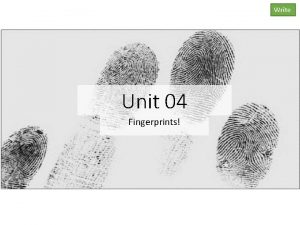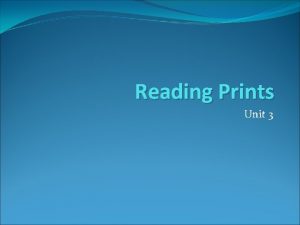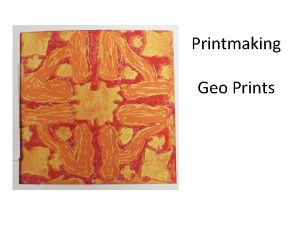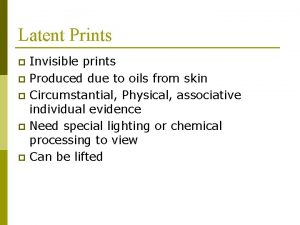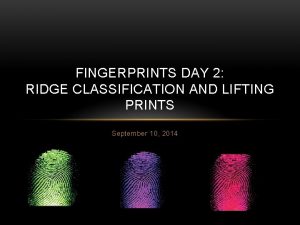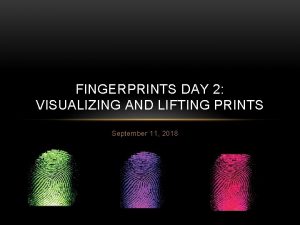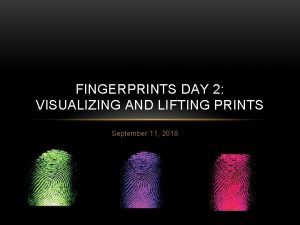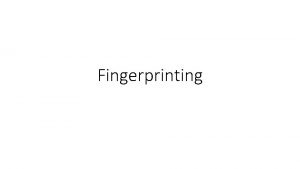Fingerprints Whose prints are they Terminology n Dactyloscopy

























































































- Slides: 89

Fingerprints

Whose prints are they? ? ?

Terminology n Dactyloscopy n n Classification of fingerprints Dactylography n Study of fingerprints for identification

History n n n William Herschel Credited to be the first person to study the persistence of friction ridge skin Uses a handprint as a signature for road building materials He later expands FP ID to courts, jails when he is placed in charge of those functions Records his own FP’s to show persistence

Alphonse Bertillon n n 1882 – proposes the use of anthropometry as a means of identification A system of body measurements for ID purposes Was used as a means of ID from 1882 – 1914 Later merged with photos and fingerprints for a complete record

Francis Galton n n Publishes first book on FP’s in 1892 First to identify individual minutiae Bifurcation n Ending ridge n Short ridge n Enclosure n n Referred to as Galton details

Juan Vucetich n n n 1891 – Argentina Begins recording FP’s of criminals and devises his own classification system First practical use of FP’s by law enforcement 1892 – Rojas murder case solved with bloody FP (1 st murder solved with FP’s) Rojas murders her 2 kids & blames a man Bloody FP @ scene is ID’ed as hers – she then confesses

Richard Henry n n 1894 – develops a FP classification system 1900 – classification system becomes the standard in England then in nearly all English speaking countries

Henry Deforest n n 1902 – begins the first systematic use of FP’s in the U. S. New York Civil Service Commission Applicants printed when they take the test and on their first day of work 1903 – New York state begins 1 st systematic use of FP’s for criminal identification

Will West & William West n n n 1903 Leavenworth Prison Nearly identical Bertillon measurements Distinguished from one another by FP’s

World Fair n n 1904 – Inspector John Ferrier of Scotland Yard Demonstrates anthropometry and FP’s Shows how FP’s can have the same Bertillon measurements but different FP’s Stays in U. S. after the Fair to teach FP development using powder

Court Cases n 1898 – murder case in Bengal, India is the first case in which FP evidence was used to secure a conviction

n n 1911 – People v. Jennings 1910 conviction for murder 1 st American appellate case regarding the admissibility of fingerprint expert testimony Court decided FP ID is a science and expert testimony was appropriate

n n n 1911 – People v. Crispi First U. S. case where conviction occurs with FP evidence alone FP expert takes inked impressions from jurors & court staff then leaves the room Jury member puts FP on piece of glass Expert returns to courtroom, examiners the prints and ID’s the juror …defendant changes plea to guilty

Skin Structure n 2 basic layers n Epidermis (external) n Dermis (true skin) n Dermal papillae

Unique characteristics n n n “Points” of comparison Persistent and unique – the basis for the science Identical twins – same DNA but different fingerprints

Types of Injury n n Temporary – epidermal layer damaged Permanent (scar) – dermal layer is damaged

Water, water n n n About 98. 5% of the fingerprint residue secreted is water This refers to natural secretions Any foreign material present on the skin can be used to transfer the fingerprint

Credibility is like virginity…you only lose it once

Delta and core n n Will appear in loops and whorls Useful for orientation but not needed for comparison

Delta and core n n n A loop will have one delta and a whorl will have at least two The delta is where the ridges separate and surround the pattern The core is the approximate center of the print

Now, don’t ya feel good about yourself!

Pattern Types

Pattern Types

Pattern Types

Pattern Types n n n Arch pattern Ridges flow in from one side and out the other Comprise about 5% of all patterns

Pattern Types n n Tented arch A sub-category of the arch pattern type

Whorls n n n Comprise 30% of all pattern types At least 2 deltas 4 different categories of the pattern

Whorl Pattern n Central pocket loop whorl n Slants to one side n 2 deltas

Whorl Pattern n n Double loop whorl Interlocking loops and 2 deltas

Whorl Pattern n n Accidental The miscellaneous category n Not a common print n More than 2 deltas

Classification Systems n Henry System n n n Numerator/denominator Based on presence of whorls NCIC System n n Old system New system Old is more descriptive Used for teletypes

Latent Print Development n Surface type n Non-Porous (does not absorb) Print is sitting atop the surface n Very fragile evidence n n Porous (absorbs) n Not as fragile but can still be damaged

Types of Impressions n n n Latent Most common Must be developed with powders or chemicals A print is not always left when an item is touched Not made under controlled circumstances

Types of Impressions n n n Molded, Plastic, Patent All mean the same The raised portion of the ridge is impressed into the surface A negative impression is left Must be photographed to be preserved The photo must then be printed reversed

Types of Impressions n n n Visible The ridges are covered with a visible substance (blood, etc) The print can be seen Take the item it is on if possible Photograph to preserve THEN try to enhance it

Handling Print Evidence n n n Minimize handling Package to limit movement Handle in an unusual manner

Miscellaneous Info n Humidity n n How old is it? n n No scientific method to determine age Position n n Important for development of latents Inside/ outside/ height Oblique light n Excellent search technique

Safety First n Material Safety Data Sheet (MSDS) material n Use of powders and chemicals n Combinations of chemicals

Latent Print Development n n The first consideration is the surface type Next the material the print is left in must be considered. Is it visible? n Is it in blood, grease, oil etc. n This will help in deciding a development technique n

Powder n n Reacts only with any moisture in the print No chemical reaction with the print and the powder n Brush lightly in one direction n To go back and forth acts like an eraser n Slowly build the contrast as prints are found

Powder n n Powders come in a variety of colors Pick a color that will give the best contrast with the surface you are processing Can applied with a fiberglass, camel hair or feather brush – personal preference and depends upon the surface Used mainly on non-porous surfaces

Magnetic Powder n Regular powder mixed with iron powder n Applied with a magnetic brush n n The brush should NOT come in contact with the surface – simply drag the powder across the surface Works well on treated papers – like magazine pages & checkbook boxes

Magnetic Powder n n n Cannot be used on metal surfaces Has been used with superglue to get prints from human skin A good technique for certain circumstances

Fluorescent powders n Must be used with a ultraviolet light or an Alternate Light Source (ALS) n These come in regular & magnetic form n Very light application is necessary n Can be lifted and/or photographed

Lifting latent impressions n Transparent tape n Hinge lifter n Rubber lifter

Properly documenting the lift n n Necessary because of cases where fingerprint lifts have been fabricated On the lift there should be: Agency case number (AFIS entry) n Collectors initials n Date and time of lift n Note the surface the lift was taken from n Diagram showing location & position n Development method used n Witness to the lift (if possible) n Address – for multiple lifts in one shift n

Ninhydrin n n n Used on porous surfaces Reacts with amino acids Prints develop purple in color Can be mixed with different carriers – acetone, methyl alcohol Applied by brushing, dipping or spraying Prints will develop in 24 -36 hours Development can be accelerated with application

Ninhydrin n n Wear nitrile gloves – not latex Certain carriers (acetone) will run some inks and melt plastic Humidity should be about 60 -80% Should NOT be used if DFO is to be used on the same item – Sequentially DFO needs to be used first

Therma-Nin n n Ninhydrin used for thermal papers – receipts A very unique paper product One side of the paper is treated to accept the heat and the ink Usually the back side is like regular paper The same item may require different processing for each side

DFO n n n Requires a laser or alternate light source Reacts with the amino acids in the print residue Shown to develop 2. 5 times more prints than ninhydrin alone Dip or spray, allow to dry and use the ALS to visualize prints Developed prints must be photographed

Silver Nitrate n n n Used for porous surfaces Reacts with sodium chloride (salt) Item is dipped – allowed to dry – and exposed to UV light Silver nitrate turns sodium chloride into silver chloride – which is sensitive to UV light Developed prints are brown

Physical Developer n n n Reacts with fats, oils and waxes Will NOT work with thermal paper Works best on older items Do not use metal on the item The item is dipped in the solution – then rinsed with tap water Contrast can be built with additional processing time

Cyanoacrylate Ester (Super glue) n n Usually the BEST method for non-porous objects The fumes react with moisture in the print residue First it binds to the residue then it binds to itself – so it is possible to over develop the print Can be made to fume by heat or chemical reaction

Superglue n n Humidity level is critical – get as close to 80% as possible Chemical reaction Reacts with a 5% solution of sodium hydroxide. This solution is placed on cotton balls/pads and the pads are allowed to dry. n Once the glue is applied to the pad fuming will occur n Or…. Dill’s pipe cleaners n

Super glue n Heat method of fuming Best if applied in a chamber – but a car or a room or an entire house can become a chamber n Can use a light bulb or hot plate for heat n Be able to shut the power off from outside of the chamber – to avoid a fire! n Above 250° it becomes toxic n Above 400° you’ve created cyanide gas…. look for another job at this point n

Super glue n n Have acetone or nail polish remover available when using this method Extra caution needs to be taken when using this at scenes – safety for heating, control of humidity, venting n Requires plenty of ventilation – do NOT rush in to complete the processing n Use a test print to ensure proper development – and prevent over development

Dye Stains n n Used on prints that have been developed using super glue The item can be dipped in to the stain or the stain can be sprayed onto the item The stain sits on the item for about one minute and is rinsed off with water The item is allowed to dry and then viewed using an Alternate Light Source (ALS)

Alternate Light Source n n n Everything either reflects light or absorbs light The ALS allows the examiner to tune throughout the visible spectrum – to get the best contrast Used for dye stains in FP work but also used for body fluids, fibers, bloodstains etc.

Small Particle Reagent (SPR) n n n Can be used on wet or dry, porous or nonporous surfaces Reacts with fats in the FP residue Sprayed onto surface and allowed to cascade over the surface Once prints are developed the surface is rinsed with water Can be photographed or dried then lifted

Unique surfaces n n n Computer cases, appliances, car interiors, stereo components Using powder and regular tape you will get the pattern of the surface The print is actually on different planes – regular tape will not conform to the irregularities

Liquid Glue n n n The glue is poured over the surface and will conform to the different planes The glue is allowed to dry and then a corner is lifted with a knife Regular tape is then placed over the dried glue and everything is lifted

Diff-Lift Tape n n n Transparent tape with a thin layer of gelatin attached to it Much easier to use – no need for extra steps The tape will need to be cut with scissors

Mikrosil n n n A silicone casting material which records minute detail Easy to mix and apply Latent prints lifted with this are reversed because this material is not transparent

Mikrosil n n Costs about $25 -30 per tube Two part mixture Silicone based casting agent with excellent detail Used to cast prints from difficult surfaces, tool marks, anything needed detail

Equal parts from each tube

Mixed together

Applied to surface

Allow several minutes to dry then remove

Many uses….

Blood Prints n n A latent print which has blood flow over it will NOT become a blood print This refers to prints which have been left because of blood on the friction ridge skin These do not react with FP residue In deciding upon a technique consider the surface type (porous, non-porous), the color of the surface versus the color of the developed print

Orthotolidine n n n Not used much any more because of significant health risks associated with it An ether based solution so care must be taken for breathing and explosions Applied by spraying and reacts with proteins in the blood Developed prints are greenish-blue Must be photographed and possibly lifted

Amido Black n n Reacts with proteins in the blood Can be used on porous & non-porous surfaces Applied by brushing, dipping or spraying Prints developed are dark green in color and must be photographed to be preserved

Hungarian Red n n n Can be used on porous surfaces Reacts with proteins in the blood More sensitive than other reagents Must be photographed and may be lifted with a gel lifter Can then be viewed with the ALS

Prints on Tape n n n There is a possibility of prints on the nonadhesive as well as the adhesive side of the tape The tape must first be separated Low heat – a hair dryer Liquid nitrogen – Un-du – commercial adhesive suspension

Liquid Nitrogen n n Freezes the adhesive and causes it to come apart Works best on adhesive to non-adhesive situations Not as good for adhesive to adhesive sides Can be found at welding supply houses Requires a styrofoam dish and gloves

Un-du n n n Commercially available adhesive remover Can be used to separate tape Works best on adhesive to non-adhesive contact Used one drop at a time and slowly removing the adhesive Substance is not patented but the “shovel” dispenser is…

Un-du n n Be careful of trace evidence Too much applied can ruin any fingerprints Suspends the adhesive quality temporarily Can be used on any adhesive – tape, envelopes, stamps…

Un-du n n n Once the tape is separated it is then processed for prints Sticky Side Powder is a good method Both sides of the tape may have prints

Automated Fingerprint Identification System (AFIS) n n A computerized database of fingerprint records Shared by Maine, New Hampshire and Vermont About 400, 000 records Searches based on characteristics on the X and Y axis

Latent Work Station

Latent print is captured

Minutiae, Pattern type, finger number

Search descriptors

Priority, rotation, # of respondents

System responses

Inked prints n n n Rolled and simultaneous impressions Thumbs go toward the body Fingers go away from the body Card must be signed by person being printed Good inked prints are crucial to the fingerprint examiner & AFIS database Fully rolled from nail to nail and to the joint break

Incomplete roll vs. Fully rolled

 Insidan region jh
Insidan region jh What is the principle of fingerprint and explain each
What is the principle of fingerprint and explain each Similarities of dactyloscopy dactylography and dactylomancy
Similarities of dactyloscopy dactylography and dactylomancy Law of multiplicity of evidence
Law of multiplicity of evidence Dactyloscopy has been a forensic practice for 3000 years.
Dactyloscopy has been a forensic practice for 3000 years. Is a scanner an input or output device
Is a scanner an input or output device Prints database
Prints database Ben shaw nudes
Ben shaw nudes Acme toy company prints baseball cards
Acme toy company prints baseball cards Ridge characteristic
Ridge characteristic Stork prints austria
Stork prints austria Andy goldsworthy print
Andy goldsworthy print What are aladdin's three wishes
What are aladdin's three wishes E prints uny
E prints uny Plumbing symbols definition
Plumbing symbols definition Plastic prints
Plastic prints Shailja tex prints pvt ltd
Shailja tex prints pvt ltd They are they which testify of me
They are they which testify of me 2. if we sneak out quietly, nobody notice.
2. if we sneak out quietly, nobody notice. Grammar rules frustrate me they're not logical they are so
Grammar rules frustrate me they're not logical they are so We seek him here we seek him there
We seek him here we seek him there For they not know what they do
For they not know what they do I have not rejected you
I have not rejected you Knowledge not shared is wasted
Knowledge not shared is wasted Rankings: what are they and do they matter?
Rankings: what are they and do they matter? Chapter 6 fingerprints
Chapter 6 fingerprints Plastic fingerprints
Plastic fingerprints Opposed bifurcation
Opposed bifurcation Chapter 6 fingerprints
Chapter 6 fingerprints Fingerprints
Fingerprints Can fingerprints be altered or disguised how
Can fingerprints be altered or disguised how Marcello malpighi contribution to fingerprints
Marcello malpighi contribution to fingerprints The study of fingerprints for identification purposes
The study of fingerprints for identification purposes The approximate center of a pattern is called
The approximate center of a pattern is called Ridge characteristics
Ridge characteristics Are fingerprint patterns inherited
Are fingerprint patterns inherited Fine structure of ridge characteristics
Fine structure of ridge characteristics First definitive study of fingerprints
First definitive study of fingerprints How are fingerprints analyzed?
How are fingerprints analyzed? Arch fingerprint
Arch fingerprint Alfred hale fingerprints
Alfred hale fingerprints Ridge characteristics can be found in
Ridge characteristics can be found in Types of fingerprints
Types of fingerprints Ulnar loop
Ulnar loop These folds shape the epidermis into fingerprints:
These folds shape the epidermis into fingerprints: Primary classification of fingerprints
Primary classification of fingerprints Marcello malpighi contribution to fingerprints
Marcello malpighi contribution to fingerprints Plastic fingerprint definition
Plastic fingerprint definition Two focal points of fingerprint
Two focal points of fingerprint Different types of fingerprints
Different types of fingerprints Types of fingerprints
Types of fingerprints Ecfps
Ecfps Iodine fuming definition forensics
Iodine fuming definition forensics Plastic fingerprints
Plastic fingerprints Chapter 6 fingerprints
Chapter 6 fingerprints Fingerprint description
Fingerprint description Most common ridge characteristics
Most common ridge characteristics Information about fingerprints
Information about fingerprints Typeline fingerprint
Typeline fingerprint Silver nitrate is a method of seeing fingerprints on
Silver nitrate is a method of seeing fingerprints on A sequence is a function whose domain is
A sequence is a function whose domain is Whose life is it anyway summary
Whose life is it anyway summary Find the value of a
Find the value of a In the adjacent figure the height of a solid cylinder
In the adjacent figure the height of a solid cylinder Once upon a time boy
Once upon a time boy Whose coat is this it's mine
Whose coat is this it's mine A substance whose water solution conducts a current is a(n)
A substance whose water solution conducts a current is a(n) Figurative language alliteration examples
Figurative language alliteration examples Use of words whose sounds echo their meanings
Use of words whose sounds echo their meanings Whose child is this
Whose child is this A woman whose weight is 530n is poised
A woman whose weight is 530n is poised Who does oedipus claim to still fear in corinth
Who does oedipus claim to still fear in corinth Whose flag is this
Whose flag is this What is a restrictive clause
What is a restrictive clause Milton paradise lost summary
Milton paradise lost summary Once upon a time there was a boy whose name was jack
Once upon a time there was a boy whose name was jack Relative pronoun練習
Relative pronoun練習 Sound of waves onomatopoeia
Sound of waves onomatopoeia Animals whose ears we cannot see
Animals whose ears we cannot see Animals which have ears that we cannot see
Animals which have ears that we cannot see A greenhouse is a building whose sides and roof
A greenhouse is a building whose sides and roof What is the sine of an obtuse angle
What is the sine of an obtuse angle Whose water is it anyway
Whose water is it anyway A block whose mass m is 680g is fastened
A block whose mass m is 680g is fastened Athenian sculptor whose true love was philosophy
Athenian sculptor whose true love was philosophy Sultan altamash built a tomb in malkapur in whose memory?
Sultan altamash built a tomb in malkapur in whose memory? Unit 1 angle relationships
Unit 1 angle relationships Frågepronomen
Frågepronomen A percent is a fraction whose denominator is 100
A percent is a fraction whose denominator is 100 The man whose arms exploded
The man whose arms exploded

